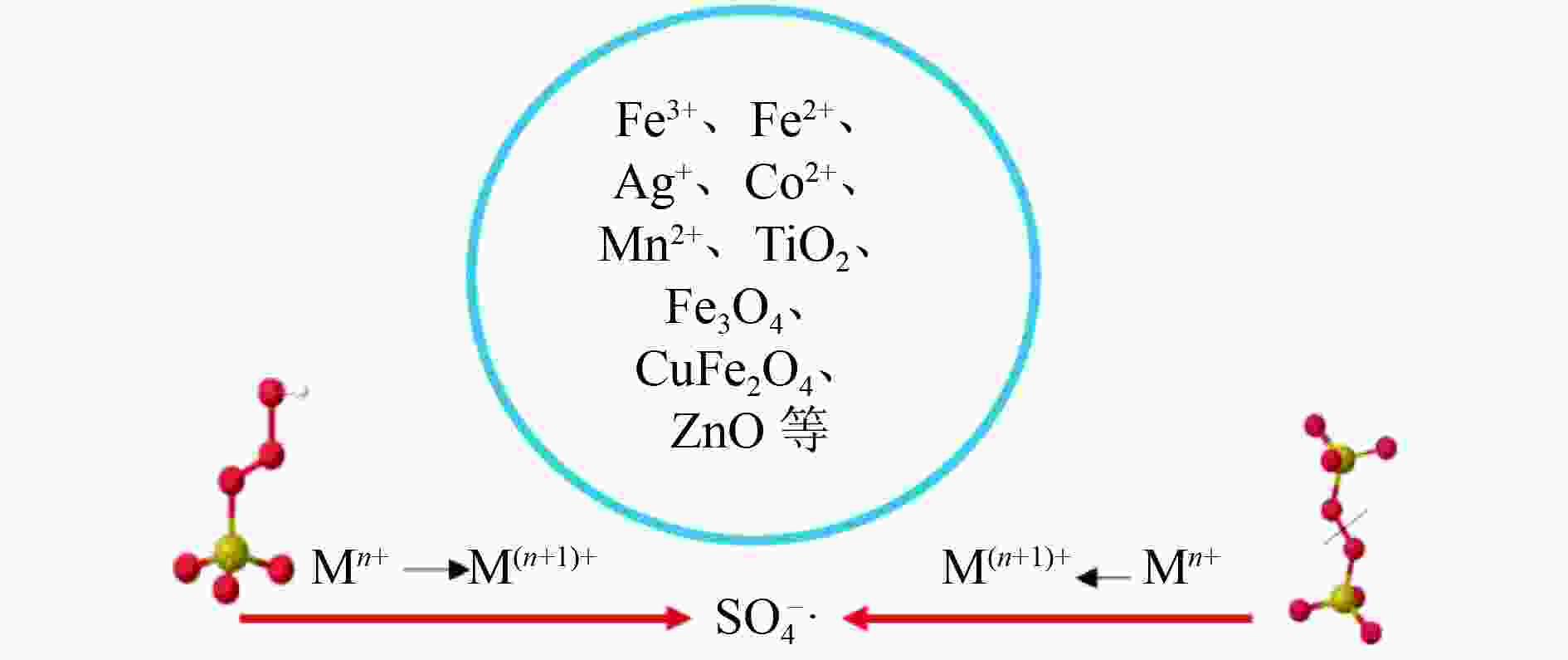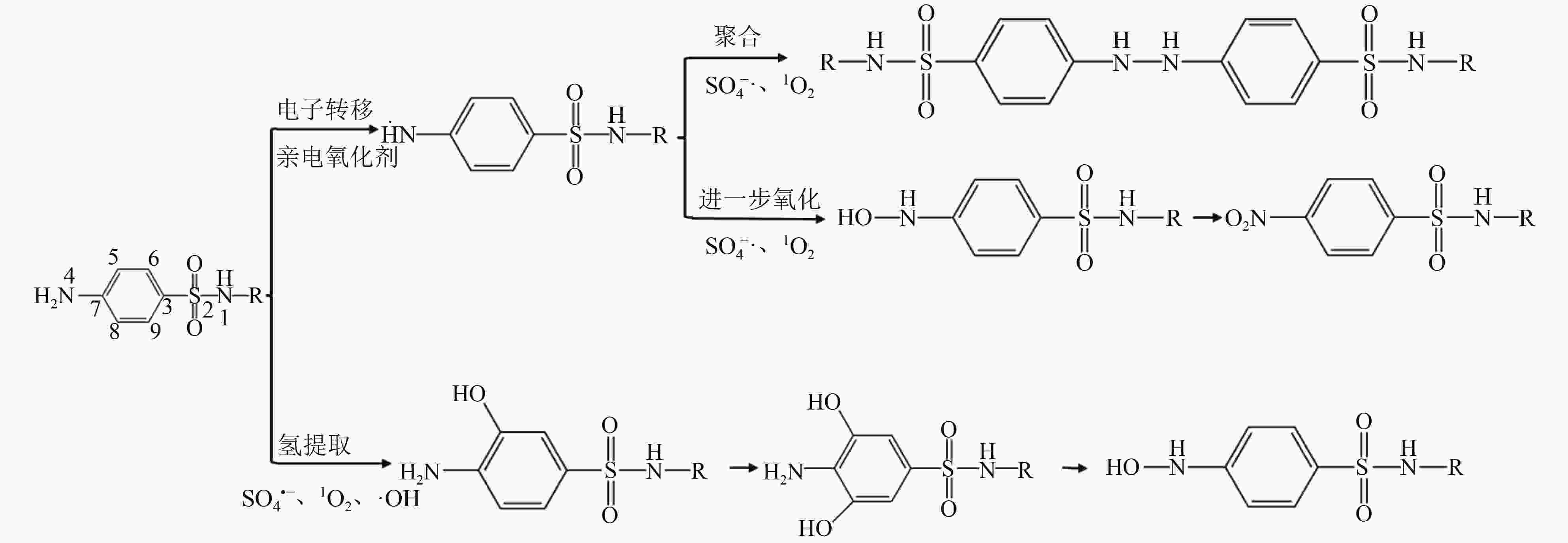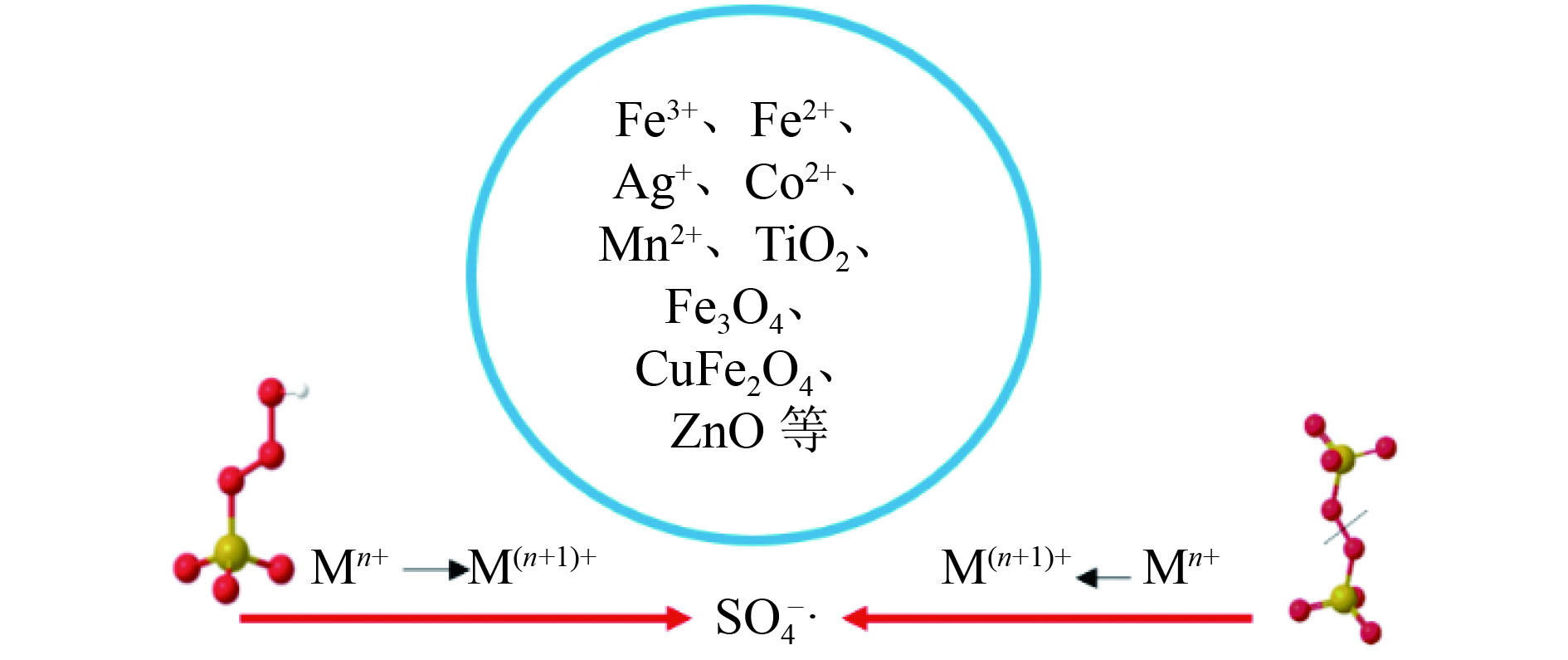Research progress of advanced oxidation technology based on persulfate activation for the treatment of sulfonamides in water
-
摘要:
磺胺类药物(SAs)是水中最常被检出的抗生素之一,传统的生物处理无法对其有效降解,研发高效降解SAs的技术具有现实意义。近年来,通过活化过硫酸盐(persulfate,PS)产生硫酸根自由基($\mathrm{SO}_4^{-}\cdot $)的高级氧化技术受到了广泛关注。聚焦于PS的各种活化方法,包括热活化、紫外活化、金属离子及金属氧化物活化、碳材料活化、金属-有机骨架材料活化等,分析了不同活化方法可能的活化机理和优缺点,综述了基于过硫酸盐活化的高级氧化技术(PS-AOPs)在SAs降解中的应用,阐述了PS-AOPs降解SAs的机制。结果表明:活化PS的机制是通过活化方法使其分子结构中的O—O键断裂,从而使PS分解形成$\mathrm{SO}_4^{-}\cdot $或其他活性物质,活化方法决定了PS-AOPs降解SAs的效率。SAs的降解途径分为自由基途径与非自由基途径,其中自由基途径主要包括苯胺部分氧化、磺酰胺基团及相邻位点(C—NH—SO2—C)的裂解等,非自由基途径包括电子传递、表面活化、单线态氧(1O2)作用等。最后,提出未来研究重点应在开发稳定高效活化PS的催化剂以及使用多种处理技术协同作用基础上,加强对SAs降解机制以及含SAs实际废水的研究。
-
关键词:
- 磺胺类药物(SAs) /
- 过硫酸盐(PS) /
- 活化 /
- 硫酸根自由基 /
- 羟基自由基
Abstract:Sulfonamide drugs (SAs) are one of the most frequently detected antibiotics in water, traditional biological treatment cannot effectively degrade sulfonamides, and thus the development of technology for efficient degradation of SAs has practical significance. In recent years, the advanced oxidation processes that generate sulfate radicals ($\mathrm{SO}_4^{-}\cdot $) by activating persulfate (PS) have received widespread attention. Various methods for the activation of PS were focused on, including thermal, ultraviolet light, metal ion and metal oxides, carbon materials and MOFs activation and so on; and their possible activation mechanisms, advantages and disadvantages were summarized. The application of advanced oxidation processes based on persulfate activation (PS-AOPs) in the degradation of sulfonamides was reviewed and the mechanism of degradation of SAs by PS-AOPs was summarized. The results showed that the activation mechanism of PS was to break O—O bond in the molecular structure, which led to the decomposition of PS to form $\mathrm{SO}_4^{-}\cdot $ or other active substances. The efficiency of PS-AOPs in degrading SAs was determined by the activation method. The degradation pathways of SAs were divided into free radical and non-free radical pathways, in which the free radical pathways mainly included partial oxidation of aniline, cleavage of sulfonamide groups and adjacent sites (${\mathrm{C—NH—}}{\mathrm{SO}}_2—{\mathrm{C}} $), and the non-free radical pathways included electron transfer, surface activation, and the role of single linear oxygen (1O2). Finally, it was suggested that the future research focus should be on the development of catalysts for stable and efficient activation of PS, as well as the synergistic effect of multiple treatment technologies. Meanwhile, research on the mechanism of SAs degradation and the actual wastewater containing SAs should be strengthened.
-
Key words:
- sulfonamides(SAs) /
- persulfates(PS) /
- activation /
- sulfate radicals /
- hydroxyl radicals
-
图 1 金属离子和金属氧化物对PDS和PMS的活化机理[24]
Figure 1. Activation mechanism of metal ions and metal oxide for PDS and PMS
表 1 PMS和PDS的基本特征
Table 1. Basic features of PMS and PDS
氧化剂 化学式 结构式 分子量 溶解度/(g/L) 氧化还原电位/V O—O键键长/Å O—O键键能/(kJ/mol) PMS HSO5 
114.07 >250 1.82 1.453 140~213.3 PDS H2S2O8 
194.13 >520 2.01 1.497 140 表 2 热活化PS降解SAs的条件与效果
Table 2. Conditions and effects of thermally activated persulfate for the degradation of SAs
表 3 紫外活化PS降解SAs的条件与效果
Table 3. Conditions and effects of UV-activated PS for the degradation of SAs
表 4 金属离子及其氧化物活化PS降解SAs的条件与效果
Table 4. Conditions and effects of metal ions and metal oxide-activated PS for the degradation of SAs
SAs类别 SAs浓度/(μmol/L) 氧化剂及浓度/(mmol/L) 催化剂 pH 反应时间/min 去除率/% SMX[25] 10 PMS,0.1 Co2+ 3 30 62.3 SMR[26] 100 PDS,0.4 Ag+ 3 240 85 SMX[27] 63047 PDS,1 849 656 Fe2+ 3 30 57.3 SD[28] 8 PMS,0.033 CuFeO2RCs 6.8 24 接近100 SMX[29] 39 PMS,0.65 CoFe2O4 7 10 91 SMM[30] 64 PDS,0.9 Fe3O4 6 180 88 SDM[30] 64 PDS,100 Fe3O4 7 180 99.8 SMX[31] 6 PDS,0.14 α-Fe2O3 6.8 180 接近100 表 5 碳材料活化PS降解SAs的条件与效果
Table 5. Conditions and effects of carbon material-activated PS for the degradation of SAs
SAs类别 催化剂 催化剂
浓度/(g/L)氧化剂
及浓度/
(mmol/L)pH 掺杂
类型去除
率/%SMX[36] 活性炭 0.1 PMS,0.5 7.2 91.2 SMX[37] 活性炭 PMS,5 95 SMX[38] 生物炭 0.05 PMS,4 氮 接近100 SMX[39] 生物炭 0.1 PDS,0.5 10 氮、硫 68.8 SCP[41] 氧化还原
石墨烯(RGO)0.2 PDS,7.39 氮 100 SMX[42] 碳纳米管
(CNTs)0.1 PMS,1 7 Fe3C 100 SMX[43] 石墨烯 0.5 PMS,800 3.4 氮 91.7 SMX[44] 石墨烯 0.05 PMS,1 6 N 99.9 表 6 MOFs材料活化PS降解SAs的条件与效果
Table 6. Conditions and effects of MOFs-activated PS for the degradation of SAs
SAs类别 催化剂 催化剂浓度/(g/L) 氧化剂及浓度/(mmol/L) pH 改性类型 去除率/% SMZ[49] MIL-10(Cr) 0.15 PDS,10 6.0 80 SMX[50] MIL/PDA 0.1 PDS,4 79.2 SMX[51] Fe-MOFs-2 1 PDS,3.7 3 调节剂 91.95 SMT[52] DMOFS 0.1 PMS,1 10 高温碳化 提高1.8倍 SMX[53] MnOx@NC 0.05 PMS,0.55 5.2 氮掺杂、碳化 72.9 SMX[54] Co-NC-C 0.1 PMS,0.74 7 碳化 接近100 SMX[55] CuFe2O4/Fe2O3 0.2 PMS,6 3.4 双金属、碳化 99.7 表 7 PS-AOPs在降解SAs过程中的主要活性物种
Table 7. Main active species in the degradation of SAs by PS-AOPs
-
[1] 卿叶, 李红芳, 张苗苗, 等. 养猪废水中磺胺嘧啶对湿地底泥中氮转化微生物及过程影响[J]. 环境科学研究,2021,34(9):2191-2199.QING Y, LI H F, ZHANG M M, et al. Effects of sulfadiazine in swine wastewater on microorganisms and nitrogen transformation processes in wetland sediment[J]. Research of Environmental Sciences,2021,34(9):2191-2199. [2] 陈宇, 许亚南, 庞燕. 抗生素赋存、来源及风险评估研究进展[J]. 环境工程技术学报,2021,11(3):562-570. doi: 10.12153/j.issn.1674-991X.20200180CHEN Y, XU Y N, PANG Y. Advances in research on the occurrence, source and risk assessment of antibiotics[J]. Journal of Environmental Engineering Technology,2021,11(3):562-570. doi: 10.12153/j.issn.1674-991X.20200180 [3] 刘四光, 张乐蒙, 黄智伟, 等. 闽江河口区水体抗生素污染特征及风险评价[J]. 渔业研究,2022,44(5):426-443.LIU S G, ZHANG L M, HUANG Z W, et al. Characteristics and risk assessment of antibiotic pollution in Minjiang River Estuary[J]. Journal of Fisheries Research,2022,44(5):426-443. [4] 宋炜, 张敬轩, 马晓斐, 等. 农村养殖场及其周边土壤中抗生素残留与风险评估[J]. 河北省科学院学报,2022,39(6):42-49. doi: 10.3969/j.issn.1001-9383.2022.6.hbskxyxb202206008SONG W, ZHANG J X, MA X F, et al. Determination and risk assessment of antibiotics in rural farms and surrounding soils[J]. Journal of the Hebei Academy of Sciences,2022,39(6):42-49. doi: 10.3969/j.issn.1001-9383.2022.6.hbskxyxb202206008 [5] HAMMESFAHR U, HEUER H, MANZKE B, et al. Impact of the antibiotic sulfadiazine and pig manure on the microbial community structure in agricultural soils[J]. Soil Biology and Biochemistry,2008,40(7):1583-1591. doi: 10.1016/j.soilbio.2008.01.010 [6] 齐亚兵, 张思敬, 孟晓荣, 等. 抗生素废水处理技术现状及研究进展[J]. 应用化工,2021,50(9):2587-2593. doi: 10.3969/j.issn.1671-3206.2021.09.054QI Y B, ZHANG S J, MENG X R, et al. The present situation and research progress of antibiotic wastewater treatment technology[J]. Applied Chemical Industry,2021,50(9):2587-2593. doi: 10.3969/j.issn.1671-3206.2021.09.054 [7] GAO Y Q, GAO N Y, CHU W H, et al. UV-activated persulfate oxidation of sulfamethoxypyridazine: kinetics, degradation pathways and impact on DBP formation during subsequent chlorination[J]. Chemical Engineering Journal,2019,370:706-715. doi: 10.1016/j.cej.2019.03.237 [8] 许若梦, 吴桐, 锁瑞娟, 等. 基于不同自由基的高级氧化技术对水中诺氟沙星的去除效果[J]. 环境工程技术学报,2020,10(3):433-439. doi: 10.12153/j.issn.1674-991X.20190177XU R M, WU T, SUO R J, et al. Removal performance of norfloxacin from waters by advanced oxidation processes based on different free radicals[J]. Journal of Environmental Engineering Technology,2020,10(3):433-439. doi: 10.12153/j.issn.1674-991X.20190177 [9] ZHAO Q, GUO W Q, LUO H C, et al. Insights into removal of sulfonamides in anaerobic activated sludge system: mechanisms, degradation pathways and stress responses[J]. Journal of Hazardous Materials,2022,423:127248. doi: 10.1016/j.jhazmat.2021.127248 [10] 代朝猛, 刘仟, 段艳平, 等. 活化过一硫酸盐技术降解环境有机污染物的研究进展[J]. 环境科学研究,2022,35(1):141-149.DAI C M, LIU Q, DUAN Y P, et al. Activation of peroxymonosulfate for environmental organic pollutants degradation: a review[J]. Research of Environmental Sciences,2022,35(1):141-149. [11] BLASIOLI S, MARTUCCI A, PAUL G, et al. Removal of sulfamethoxazole sulfonamide antibiotic from water by high silica zeolites: a study of the involved host–guest interactions by a combined structural, spectroscopic, and computational approach[J]. Journal of Colloid and Interface Science,2014,419:148-159. doi: 10.1016/j.jcis.2013.12.039 [12] WANG J L, WANG S Z. Activation of persulfate (PS) and peroxymonosulfate (PMS) and application for the degradation of emerging contaminants[J]. Chemical Engineering Journal,2018,334:1502-1517. doi: 10.1016/j.cej.2017.11.059 [13] ZHOU L, YANG X R, JI Y F, et al. Sulfate radical-based oxidation of the antibiotics sulfamethoxazole, sulfisoxazole, sulfathiazole, and sulfamethizole: the role of five-membered heterocyclic rings[J]. Science of the Total Environment,2019,692:201-208. doi: 10.1016/j.scitotenv.2019.07.259 [14] FAN Y, JI Y F, KONG D Y, et al. Kinetic and mechanistic investigations of the degradation of sulfamethazine in heat-activated persulfate oxidation process[J]. Journal of Hazardous Materials,2015,300:39-47. doi: 10.1016/j.jhazmat.2015.06.058 [15] MILH H, CABOOTER D, DEWIL R. Role of process parameters in the degradation of sulfamethoxazole by heat-activated peroxymonosulfate oxidation: radical identification and elucidation of the degradation mechanism[J]. Chemical Engineering Journal,2021,422:130457. doi: 10.1016/j.cej.2021.130457 [16] HERRMANN H. On the photolysis of simple anions and neutral molecules as sources of O−/OH, ${\mathrm{SO}}_x^- $ and Cl in aqueous solution[J]. Physical Chemistry Chemical Physics,2007,9(30):3935-3964. doi: 10.1039/B618565G [17] CUI C Z, JIN L, JIANG L, et al. Removal of trace level amounts of twelve sulfonamides from drinking water by UV-activated peroxymonosulfate[J]. Science of the Total Environment,2016,572:244-251. doi: 10.1016/j.scitotenv.2016.07.183 [18] ACOSTA-RANGEL A, SÁNCHEZ-POLO M, POLO A M S, et al. Sulfonamides degradation assisted by UV, UV/H2O2 and UV/K2S2O8: efficiency, mechanism and byproducts cytotoxicity[J]. Journal of Environmental Management,2018,225:224-231. [19] GAO Y Q, GAO N Y, DENG Y, et al. Ultraviolet (UV) light-activated persulfate oxidation of sulfamethazine in water[J]. Chemical Engineering Journal,2012,195/196:248-253. doi: 10.1016/j.cej.2012.04.084 [20] ZHANG Y Y, LI L Y, PAN Z H, et al. Degradation of sulfamethoxazole by UV/persulfate in different water samples: influential factors, transformation products and toxicity[J]. Chemical Engineering Journal,2020,379:122354. doi: 10.1016/j.cej.2019.122354 [21] PRIYANKA YADAV M S, NEGHI N, KUMAR M, et al. Photocatalytic-oxidation and photo-persulfate-oxidation of sulfadiazine in a laboratory-scale reactor: analysis of catalyst support, oxidant dosage, removal-rate and degradation pathway[J]. Journal of Environmental Management,2018,222:164-173. [22] YANG Y, LU X L, JIANG J, et al. Degradation of sulfamethoxazole by UV, UV/H2O2 and UV/persulfate (PDS): formation of oxidation products and effect of bicarbonate[J]. Water Research,2017,118:196-207. doi: 10.1016/j.watres.2017.03.054 [23] BALL D L, EDWARDS J O. The kinetics and mechanism of the decomposition of Caro's acid. Ⅰ[J]. Journal of the American Chemical Society,1956,78(6):1125-1129. doi: 10.1021/ja01587a011 [24] ANIPSITAKIS G P, DIONYSIOU D D. Degradation of organic contaminants in water with sulfate radicals generated by the conjunction of peroxymonosulfate with cobalt[J]. Environmental Science & Technology,2003,37(20):4790-4797. [25] 刘桂芳, 管威霆, 张玉平, 等. Co2+活化过硫酸盐降解水中的磺胺甲噁唑[J]. 高校化学工程学报,2022,36(2):268-275. doi: 10.3969/j.issn.1003-9015.2022.02.015LIU G F, GUAN W T, ZHANG Y P, et al. Degradation of sulfamethoxazole in aqueous solution by cobaltous activated peroxymonosulfate[J]. Journal of Chemical Engineering of Chinese Universities,2022,36(2):268-275. doi: 10.3969/j.issn.1003-9015.2022.02.015 [26] ANIPSITAKIS G P, DIONYSIOU D D. Radical generation by the interaction of transition metals with common oxidants[J]. Environmental Science & Technology,2004,38(13):3705-3712. [27] 杜杰. Fe2+-过硫酸盐体系氧化水中磺胺类物质的研究[D]. 大连: 大连理工大学, 2022. [28] OYEKUNLE D T, GENDY E A, IFTHIKAR J, et al. Heterogeneous activation of persulfate by metal and non-metal catalyst for the degradation of sulfamethoxazole: a review[J]. Chemical Engineering Journal,2022,437:135277. doi: 10.1016/j.cej.2022.135277 [29] FENG Y, WU D L, DENG Y, et al. Sulfate radical-mediated degradation of sulfadiazine by CuFeO2 rhombohedral crystal-catalyzed peroxymonosulfate: synergistic effects and mechanisms[J]. Environmental Science & Technology,2016,50(6):3119-3127. [30] 李英豪. 铁钴氧化物活化过硫酸盐降解磺胺甲噁唑的研究[D]. 昆明: 昆明理工大学, 2022. [31] FENG Y, LIAO C Z, LI H K, et al. Cu2O-promoted degradation of sulfamethoxazole by α-Fe2O3-catalyzed peroxymonosulfate under circumneutral conditions: synergistic effect, Cu/Fe ratios, and mechanisms[J]. Environmental Technology, 2018, 39(1): 1-11. [32] DEVI P, DAS U, DALAI A K. In-situ chemical oxidation: principle and applications of peroxide and persulfate treatments in wastewater systems[J]. Science of the Total Environment,2016,571:643-657. doi: 10.1016/j.scitotenv.2016.07.032 [33] KARTHIKEYAN S, BOOPATHY R, SEKARAN G. In situ generation of hydroxyl radical by cobalt oxide supported porous carbon enhance removal of refractory organics in tannery dyeing wastewater[J]. Journal of Colloid and Interface Science,2015,448:163-174. doi: 10.1016/j.jcis.2015.01.066 [34] DUAN X G, SUN H Q, KANG J, et al. Insights into heterogeneous catalysis of persulfate activation on dimensional-structured nanocarbons[J]. ACS Catalysis,2015,5(8):4629-4636. doi: 10.1021/acscatal.5b00774 [35] JANS U, HOIGNÉ J. Activated carbon and carbon black catalyzed transformation of aqueous ozone into OH-radicals[J]. Ozone:Science & Engineering,1998,20(2):175. [36] LIANG J, XU X Y, QAMAR ZAMAN W, et al. Different mechanisms between biochar and activated carbon for the persulfate catalytic degradation of sulfamethoxazole: roles of radicals in solution or solid phase[J]. Chemical Engineering Journal,2019,375:121908. doi: 10.1016/j.cej.2019.121908 [37] SONG H R, YAN L X, JIANG J, et al. Enhanced degradation of antibiotic sulfamethoxazole by electrochemical activation of PDS using carbon anodes[J]. Chemical Engineering Journal,2018,344:12-20. doi: 10.1016/j.cej.2018.03.050 [38] QI Y F, GE B X, ZHANG Y Q, et al. Three-dimensional porous graphene-like biochar derived from Enteromorpha as a persulfate activator for sulfamethoxazole degradation: role of graphitic N and radicals transformation[J]. Journal of Hazardous Materials,2020,399:123039. doi: 10.1016/j.jhazmat.2020.123039 [39] GUAN C T, JIANG J, PANG S Y, et al. Nonradical transformation of sulfamethoxazole by carbon nanotube activated peroxydisulfate: kinetics, mechanism and product toxicity[J]. Chemical Engineering Journal,2019,378:122147. doi: 10.1016/j.cej.2019.122147 [40] WANG S Z, WANG J L. Nitrogen doping sludge-derived biochar to activate peroxymonosulfate for degradation of sulfamethoxazole: modulation of degradation mechanism by calcination temperature[J]. Journal of Hazardous Materials,2021,418:126309. doi: 10.1016/j.jhazmat.2021.126309 [41] KANG J, DUAN X G, ZHOU L, et al. Carbocatalytic activation of persulfate for removal of antibiotics in water solutions[J]. Chemical Engineering Journal,2016,288:399-405. doi: 10.1016/j.cej.2015.12.040 [42] SHANG Y N, CHEN C, ZHANG P, et al. Removal of sulfamethoxazole from water via activation of persulfate by Fe3C@NCNTs including mechanism of radical and nonradical process[J]. Chemical Engineering Journal,2019,375:122004. doi: 10.1016/j.cej.2019.122004 [43] WANG S Z, XU L J, WANG J L. Nitrogen-doped graphene as peroxymonosulfate activator and electron transfer mediator for the enhanced degradation of sulfamethoxazole[J]. Chemical Engineering Journal,2019,375:122041. doi: 10.1016/j.cej.2019.122041 [44] CHEN H, CARROLL K C. Metal-free catalysis of persulfate activation and organic-pollutant degradation by nitrogen-doped graphene and aminated graphene[J]. Environmental Pollution,2016,215:96-102. doi: 10.1016/j.envpol.2016.04.088 [45] FURUKAWA H, CORDOVA K E, O’KEEFFE M, et al. The chemistry and applications of metal-organic frameworks[J]. Science,2013,341(6149):1230444. doi: 10.1126/science.1230444 [46] WANG B, LV X L, FENG D W, et al. Highly stable Zr(Ⅳ)-based metal-organic frameworks for the detection and removal of antibiotics and organic explosives in water[J]. Journal of the American Chemical Society,2016,138(19):6204-6216. doi: 10.1021/jacs.6b01663 [47] WANG Y R, CHU W. Degradation of a xanthene dye by Fe(Ⅱ)-mediated activation of Oxone process[J]. Journal of Hazardous Materials,2011,186(2/3):1455-1461. [48] PU M J, NIU J F, BRUSSEAU M L, et al. Ferrous metal-organic frameworks with strong electron-donating properties for persulfate activation to effectively degrade aqueous sulfamethoxazole[J]. Chemical Engineering Journal,2020,394:125044. doi: 10.1016/j.cej.2020.125044 [49] HUANG X L, HU Q, GAO L, et al. Adsorption characteristics of metal-organic framework MIL-101(Cr) towards sulfamethoxazole and its persulfate oxidation regeneration[J]. RSC Advances,2018,8(49):27623-27630. doi: 10.1039/C8RA04789H [50] HOU J, WAN J Q, YAN Z C, et al. A novel polydopamine-modified metal organic frameworks catalyst with enhanced catalytic performance for efficient degradation of sulfamethoxazole in wastewater[J]. Chemosphere, 2022, 297: 134100. [51] SUN J, WAN J Q, WANG Y, et al. Modulated construction of Fe-based MOF via formic acid modulator for enhanced degradation of sulfamethoxazole: design, degradation pathways, and mechanism[J]. Journal of Hazardous Materials,2022,429:128299. doi: 10.1016/j.jhazmat.2022.128299 [52] YANG Q, CHEN D, CHU L B, et al. Enhancement of ionizing radiation-induced catalytic degradation of antibiotics using Fe/C nanomaterials derived from Fe-based MOFs[J]. Journal of Hazardous Materials,2020,389:122148. doi: 10.1016/j.jhazmat.2020.122148 [53] ZHAO Y, ZHAN X H, SUN Y P, et al. MnO x @N-doped carbon nanosheets derived from Mn-MOFs and g-C3N4 for peroxymonosulfate activation: electron-rich Mn center induced by N doping[J]. Chemosphere,2023,310:136937. doi: 10.1016/j.chemosphere.2022.136937 [54] LIU H, HE Z L, WANG S G, et al. CoZn-ZIF and melamine co-derived double carbon layer matrix supported highly dispersed and exposed Co nanoparticles for efficient degradation of sulfamethoxazole[J]. Chemical Engineering Journal,2023,469:144054. doi: 10.1016/j.cej.2023.144054 [55] HU T, DENG F X, FENG H P, et al. Fe/Co bimetallic nanoparticles embedded in MOF-derived nitrogen-doped porous carbon rods as efficient heterogeneous electro-Fenton catalysts for degradation of organic pollutants[J]. Applied Materials Today,2021,24:101161. doi: 10.1016/j.apmt.2021.101161 [56] LIANG P, ZHANG C, DUAN X G, et al. An insight into metal organic framework derived N-doped graphene for the oxidative degradation of persistent contaminants: formation mechanism and generation of singlet oxygen from peroxymonosulfate[J]. Environmental Science:Nano,2017,4(2):315-324. doi: 10.1039/C6EN00633G [57] WEI Y, SU H R, ZHANG Y W, et al. Efficient peroxodisulfate activation by iodine vacancy rich bismuth oxyiodide: a vacancy induced mechanism[J]. Chemical Engineering Journal,2019,375:121971. doi: 10.1016/j.cej.2019.121971 [58] RASTOGI A, AL-ABED S R, DIONYSIOU D D. Sulfate radical-based ferrous–peroxymonosulfate oxidative system for PCBs degradation in aqueous and sediment systems[J]. Applied Catalysis B:Environmental,2009,85(3/4):171-179. [59] YU H, CHEN J W, XIE H B, et al. Ferrate(Ⅵ) initiated oxidative degradation mechanisms clarified by DFT calculations: a case for sulfamethoxazole[J]. Environmental Science Processes & Impacts,2017,19(3):370-378. [60] GE P, YU H, CHEN J W, et al. Photolysis mechanism of sulfonamide moiety in five-membered sulfonamides: a DFT study[J]. Chemosphere,2018,197:569-575. doi: 10.1016/j.chemosphere.2018.01.041 [61] SHAD A, LI C G, ZUO J L, et al. Understanding the ozonated degradation of sulfadimethoxine, exploration of reaction site, and classification of degradation products[J]. Chemosphere,2018,212:228-236. doi: 10.1016/j.chemosphere.2018.08.050 [62] CRIQUET J, LEITNER N K V. Degradation of acetic acid with sulfate radical generated by persulfate ions photolysis[J]. Chemosphere,2009,77(2):194-200. doi: 10.1016/j.chemosphere.2009.07.040 [63] YIN R L, GUO W Q, WANG H Z, et al. Selective degradation of sulfonamide antibiotics by peroxymonosulfate alone: direct oxidation and nonradical mechanisms[J]. Chemical Engineering Journal,2018,334:2539-2546. doi: 10.1016/j.cej.2017.11.174 [64] YIN R L, GUO W Q, REN N Q, et al. New insight into the substituents affecting the peroxydisulfate nonradical oxidation of sulfonamides in water[J]. Water Research,2020,171:115374. doi: 10.1016/j.watres.2019.115374 [65] LEE H, KIM H I, WEON S, et al. Activation of persulfates by graphitized nanodiamonds for removal of organic compounds[J]. Environmental Science & Technology,2016,50(18):10134-10142. [66] LEE H, LEE H J, JEONG J, et al. Activation of persulfates by carbon nanotubes: oxidation of organic compounds by nonradical mechanism[J]. Chemical Engineering Journal,2015,266:28-33. doi: 10.1016/j.cej.2014.12.065 [67] LI J C, ZHAO L, FENG M B, et al. Abiotic transformation and ecotoxicity change of sulfonamide antibiotics in environmental and water treatment processes: a critical review[J]. Water Research,2021,202:117463. ◇ doi: 10.1016/j.watres.2021.117463 -





 下载:
下载:




